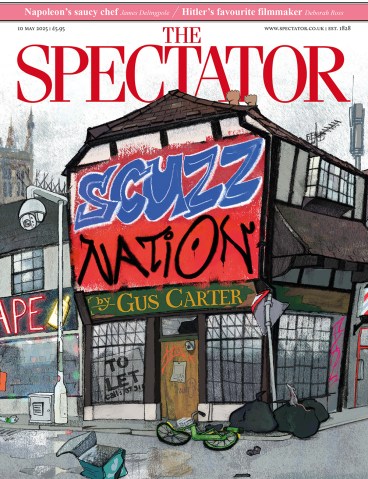
Why is Hiroshige’s work so delightful? While his close predecessor Hokusai has more drama in his draughtsmanship, Hiroshige’s pastoral visions conjure a sense of timeless continuity that appealed to his contemporaries as much as to present-day teens who love the merch. His is a world in which everything has happened before, and will happen again. People race for shelter from a sudden shower of rain; a finely dressed lady adjusts her slipping belt. Human life seems small and predictable against his vast mountains and limpid lakes.
The tranquillity is achieved in part through colour gradation, similar to millennials’ beloved ombré, and known in Edo-period Japan as bokashi, a technique carried out by his printers using a bamboo-bound lacquer tool called a baren (there’s a film in the exhibition if you’re interested). Hiroshige creates an illusory world that is both real and decorative. He offers reportage – in the preface to One Hundred Views of Fuji, published in 1859, he promised ‘views I had before my eyes… entirely true-to-life landscapes’ – but at the same time he winnows away all unpleasantness, so that we can for a moment believe the world is an elegant place.
This was a powerfully useful fantasy, because late-Edo Japan was in crisis. When Hiroshige was at the height of his powers in the 1830s, the Tokugawa shogunate’s long policy of isolationism (sakoku) was wearing increasingly thin: there was famine, a resurgence in oppressive social rules, and the intimidating presence of foreign warships along the coast, leading up to the incursion of Commodore Perry’s Black Ships into Edo harbour in 1853. No wonder the poise and gentleness of Hiroshige was so desirable, with huge print runs of his subtle, engaging works such as ‘Listening to Insects at Dokan Hill’ (c.1840). You can hear the susurrus in the early evening, and the child happily exclaiming over her captured crickets, while the adults, gazing out to sea, see only the moon.
Censorship was active at the time, and prints bore the mark not only of the skilled craftsmen who carved the cherrywood block after Hiroshige’s design, but also of the censor who checked it over. Hiroshige’s work is playful – it had to be. In a print showing a samurai procession, even the two tiny puppies playing in the gutter bow their heads to the noble procession, unless… one is discreetly offering its bottom in that direction?
Hiroshige himself was from the samurai class, but his family was not wealthy and worked as fire wardens in Edo. Occasionally, he depicts a wooden observational tower; he would well have known how it felt to view the city from a height, and with a watchful eye. Perhaps this contributed to his lofty landscapes, his feeling for multiple perspectives. It is testament to the open-ended, scholarly curation of this show that one is left to make such speculations oneself. The British Museum has huge expertise in prints and you feel in safe hands, learning to discriminate between early and late productions in a print run (early ones are brighter, but might betray the grain of the cherrywood). In terms of curation, the storytelling could be better and the show opens with a brief animation that adds little except a sense of seasickness
Hiroshige winnows away all unpleasantness, so that we can believe the world is an elegant place
Hiroshige died in 1858; a decade later, Edo Japan had given way to Meiji rule and radical modernisation had begun. Hiroshige’s work captures the spirit of 200 years of introspection about to come to an end. It is as decorative and fond as a Cavalier poem (‘Goe, lovely rose’) or a late Edwardian ditty. Hiroshige’s artist son-in-law called himself Hiroshige II; after his daughter divorced him, her next husband became Hiroshige III. It wasn’t a family name, but a working title, from the time when an artist was officially a craftsperson.
You can hear the susurrus in the early evening, and the child happily exclaiming over her captured crickets
The slightly lacklustre section on Hiroshige’s legacy includes Julian Opie’s lenticular views of Fuji, but Van Gogh’s oil-paint Hiroshige studies are missing in action (I guess the Amsterdam museum likes having them around). However there is, for a final moment of rapture, Van Gogh’s sepia-toned bird’s-eye view of Arles, made, as it were, from a fire warden’s perspective. It was, as Van Gogh wrote in 1888, ‘the most truly Japanese thing I have done’.








Comments